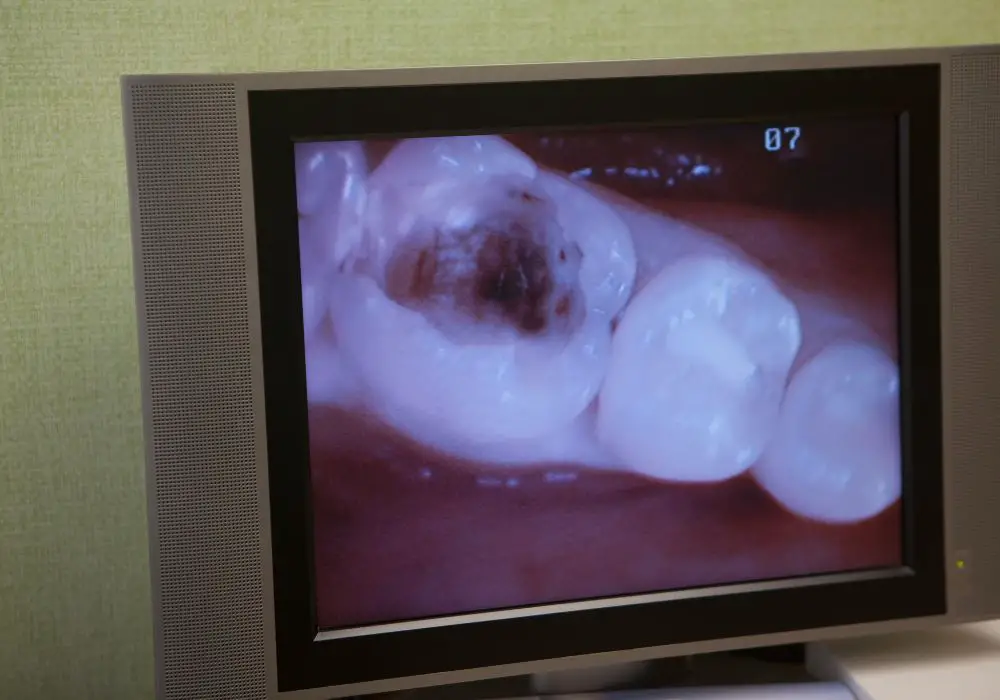Tooth decay leading to cavities is an extremely prevalent problem affecting people of all ages. Cavities develop from acids produced by bacteria in the mouth that erode and demineralize the tooth’s enamel and dentin layers. If caught early, cavities can often be arrested and reversed. But what if a hole has already formed – is there still hope for saving the tooth? With modern dentistry, the answer is usually yes. Even teeth with fairly deep decay may be restored with the appropriate treatment.
An in-depth look at the tooth decay process
Before learning how to save cavitized teeth, it helps to closely examine the sequence of the disease. Tooth decay develops in a slow, multistage process:
Stage 1: White spot lesion
The earliest sign of decay is a dull, chalky white spot on the enamel surface. This indicates an area of demineralization beneath the intact surface where minerals have been dissolved by acid. Although enamel looks intact, it has lost some mineral strength at this weakened spot.
Stage 2: Brown spot lesion
Over weeks to months, the white spot may take on a yellow to dark brown color as the decay progresses deeper and bacterial byproducts seep into the lesion. The enamel surface is now visibly discolored but still unbroken.
Stage 3: Enamel cavity formation
The demineralized enamel finally breaks down, forming a small hole or pit in the enamel surface. As acids continue invading the tooth interior, this cavity grows progressively larger. Once the enamel is penetrated, rapid decay of the underlying dentin tissue follows.
Stage 4: Dentin cavity progression
The cavity spreads through the softer dentin layer as minerals leach out from the acid exposure. Unchecked advancement reaches the inner pulp cavity, allowing bacteria to infect the root canals. The patient now has a true dental abscess, often accompanied by severe pain.
Stage 5: Tooth destruction
In its final stages, advancing decay causes enough tooth structure loss to undermine the tooth’s structural integrity. The tooth is prone to fracture, which may lead to partial or total tooth loss.
This illustrates the importance of preventing cavities in the beginning and not allowing progression to extensive decay. However, even teeth with established holes and dental caries still have a good chance of being saved with today’s dental techniques.
Signs you may have a cavity requiring treatment

Some of the most common signs indicating a cavity is present in your tooth include:
- Tooth discomfort when eating hot, cold, sweet, or acidic foods
- Lingering pain when pressure is applied to a specific tooth or area
- Visible holes or pits in enamel noticed when examining your teeth
- Brown, black or white stained areas on any tooth surfaces
- Bad breath or bad taste that seems to come from a certain tooth
- Sensitivity to hot, cold, or air hitting your teeth
If you notice any of these symptoms, see your dentist right away for an evaluation. Leaving decay untreated allows further destruction, risking the tooth’s vitality. Don’t wait for excessive pain or abscess formation to seek help.
Consequences of not treating tooth decay
Avoiding treatment of a known cavity will lead to the following progressive consequences:
1. Increasing tooth damage
A cavity becomes larger and deeper over time, reaching the inner dentin and pulp layers. More extensive decay makes restoration procedures more complex, costly, and time consuming.
2. Risk of infection
Bacteria gain access to the tooth’s inner chambers and spread infection into the root canals and surrounding bone. Abscesses develop, which can have widespread oral and systemic health risks if left alone.
3. Possible tooth loss
Unchecked decay may eventually destroy so much tooth structure that extraction is the only option. This leaves gaps in your smile and bite that require bridges or implants to restore, at great expense.
4. Spread to other teeth
Cavities breed more cavities. Leaving one decayed tooth unattended allows cavity-causing bacteria to multiply and spread their acidic byproducts to other teeth, escalating chances of new lesions.
5. Negative effects on self-esteem
Advanced tooth decay can become visibly unappealing, leading to embarrassment and avoiding smiling. Lack of treatment adversely impacts social, psychological, and mental well-being.
Don’t take chances with your dental health – get examinations on schedule and treat cavities promptly. Intervening early while the cavity is small offers the best opportunity for stopping and reversing the decay process.
X-ray and diagnostic tools for detecting cavities

Your dentist has a variety of methods available to find cavities in their earliest stages, even before you may notice any symptoms:
- Visual inspection – The dentist thoroughly examines all tooth surfaces, looking for discoloration or tiny holes indicating decay. Fiber-optic lighting is used to illuminate the smallest defects.
- Dental explorer – This thin metal pick is gently moved across enamel to feel for any stickiness, softness or indentations signaling early demineralization.
- X-rays – Powerful x-ray films pass through the tooth, revealing cavities that are not yet visible on surface enamel as well as those between teeth.
- Laser fluorescence – A laser light shined on teeth causes emission of fluorescent signals that are analyzed for indications of early decay.
- Fiber-optic transillumination – Strong light passed through a tooth shows decay near the surface by differences in light transmission and shadows.
- Electronic caries monitor – This technology uses electrical conductance readings to map demineralization under the enamel from caries.
These techniques allow the earliest stages of tooth decay to be caught, before a cavity fully forms. Your dentist can then take preventive action to remineralize weakened areas and stop further progression.
Treating small cavities
Detecting caries when the enamel surface has just been penetrated offers the best prognosis for a minimally invasive restoration. Here are common treatments used for small cavities:
- Fluoride therapy – Professionally applied high-dose fluoride varnish or gel helps remineralize porous decayed regions of enamel and dentin. For maximum effectiveness, treatment is repeated periodically.
- Remineralizing agents – Chemical agents such as CPP-ACP complex or novamin bind to teeth and attract calcium and phosphate ions, rebuilding mineral content. These are applied as dental creams or incorporated into composite restorations.
- Sealants – A plastic coating seals grooves and pits on chewing surfaces, creating a barrier that blocks food and bacteria from entering and continuing decay.
- Resin infiltration – This technique fills and reinforces subsurface lesions and small cavities with thin fluid resins that infiltrate the porous demineralized enamel and harden.
- Silver diamine fluoride – Drops of this liquid stop active decay by killing bacteria and remineralizing lesions. Already affected dentin turns black but decay is arrested.
- Composite fillings – If decay penetrates beyond options for remineralization, composite resins matched to natural tooth color are used to conservatively fill cavities.
Treating cavities that require traditional fillings
Once a definitive cavity hole extends well into dentin, more invasive procedures are needed to fully remove the decay and rebuild the tooth:
1. Anesthesia – Local anesthesia is administered to block pain during the procedure.
2. Isolation – A rubber dam is often placed to isolate the tooth and keep the area clean and dry.
3. Decay removal – Dentists use a dental drill with a small burr to gain access to the decayed section and mechanically excavate all demineralized and contaminated tooth structure. Hand instruments may also help detach decay.
4. Disinfection – The prepared cavity is rinsed, disinfected with chlorhexidine or other antimicrobials, and sometimes lightly etched with acids.
5. Matrix placement – If required, a matrix band wraps around the tooth to contour its anatomy so restorative materials can rebuild it to the proper shape.
6. Restoration and bonding – The cleaned and treated cavity is filled with metal amalgam, composite, gold or other restorative substance and sealed into place with bonding agents.
7. Polishing – Once hardened, the filling is shaped and smoothed, then polished to match the sheen of surrounding enamel.
Regular good oral hygiene and fluoride exposure helps strengthened restored teeth against new caries. Filled cavities should last many years before needing replacement, especially if detected and treated early.
Treating advanced tooth decay

Teeth with extensive structural loss from rampant or longstanding decay pose a more difficult restorative challenge. Some advanced treatment modalities for severely decayed teeth include:
- Root canal therapy – If the pulp chamber becomes infected, the inner tissues are removed and canals cleaned and sealed to save the tooth. A crown is placed afterward.
- Partial crowns – When a large section of the crown structure is missing but healthy tooth remains at the gum line, a partial crown can be fitted over the fragile remaining walls.
- Crowns or onlays – For teeth with insufficient bulk to support a basic filling but still salvageable, full coverage crowns reinforce and protect the remaining architecture.
- Tooth splinting – Loose, mobile teeth stabilized with wire lacing or composite bonds to neighboring firm teeth. This may buy time to treat advanced decay and improve tooth prognosis.
- Dental implants – If the decay is so severe that extraction is unavoidable, a dental implant surgically inserted into the bone can replace the missing tooth root and support a synthetic crown.
With today’s advancing procedures, dental providers can be very creative in finding ways to restore form and function even in badly broken down teeth.
Can further cavities be prevented after restorations?
It’s possible for new decay to form around existing fillings or underneath dental crowns if proper precautions are not taken. Follow these tips to avoid recurrent caries after cavity restoration:
- Maintain meticulous daily oral hygiene by brushing and flossing around all restoration margins.
- Use fluoride toothpaste and fluoride rinses to strengthen enamel.
- Avoid constant snacking and limit sugary foods and acidic drinks that promote decay.
- Have regular dental cleanings and exams to detect any new demineralization early.
- Watch for cracks in fillings or loose crowns that allow bacteria entry into crevices.
- Repair defective restorations promptly before decay develops underneath.
- Consider dental sealants to protect susceptible pits and fissures from renewed infection.
The outlook is bright for preserving your natural smile despite some existing decay. With early intervention and advances in adhesive and regenerative dentistry, even structurally compromised teeth with holes have a fighting chance of being reinforced, rebuilt, and protected against further destruction.
Frequently Asked Questions
Q: What are the stages of a cavity?
A: Cavities develop slowly through several stages: 1) White spot lesion from initial demineralization beneath intact enamel. 2) Discoloration as the spot darkens. 3) Enamel cavity forms as surface breaks down. 4) Dentin decay enlarges the cavity. 5) Severe decay undermines tooth integrity, risking fracture and loss.
Q: Can cavities remineralize?
A: Yes, early white spot lesions and shallow enamel cavities can remineralize with fluoride therapy, calcium phosphate pastes, and improving oral hygiene. But once in the dentin layer, cavities require traditional filling.
Q: Is a cavity a hole in a tooth?
A: Technically, a cavity forms when loss of enamel structure leads to an actual hole or gap in the tooth surface. This allows entry of bacteria deeper into tooth layers, fueling more decay. Holes require restorative dentistry.
Q: Can you get a cavity without having a hole?
A: Cavity progression starts with subsurface demineralization before an actual hole opens up. So you can have tooth decay without a visible hole or brown spot yet. That’s why dental exams are so important to detect issues early.
Q: Should cavities always be filled?
A: Yes, once a definitive cavity hole reaching the dentin forms, it won’t remineralize alone so filling is needed to prevent spread of infection and loss of tooth structure. The goal is to fill cavities early before they enlarge.







